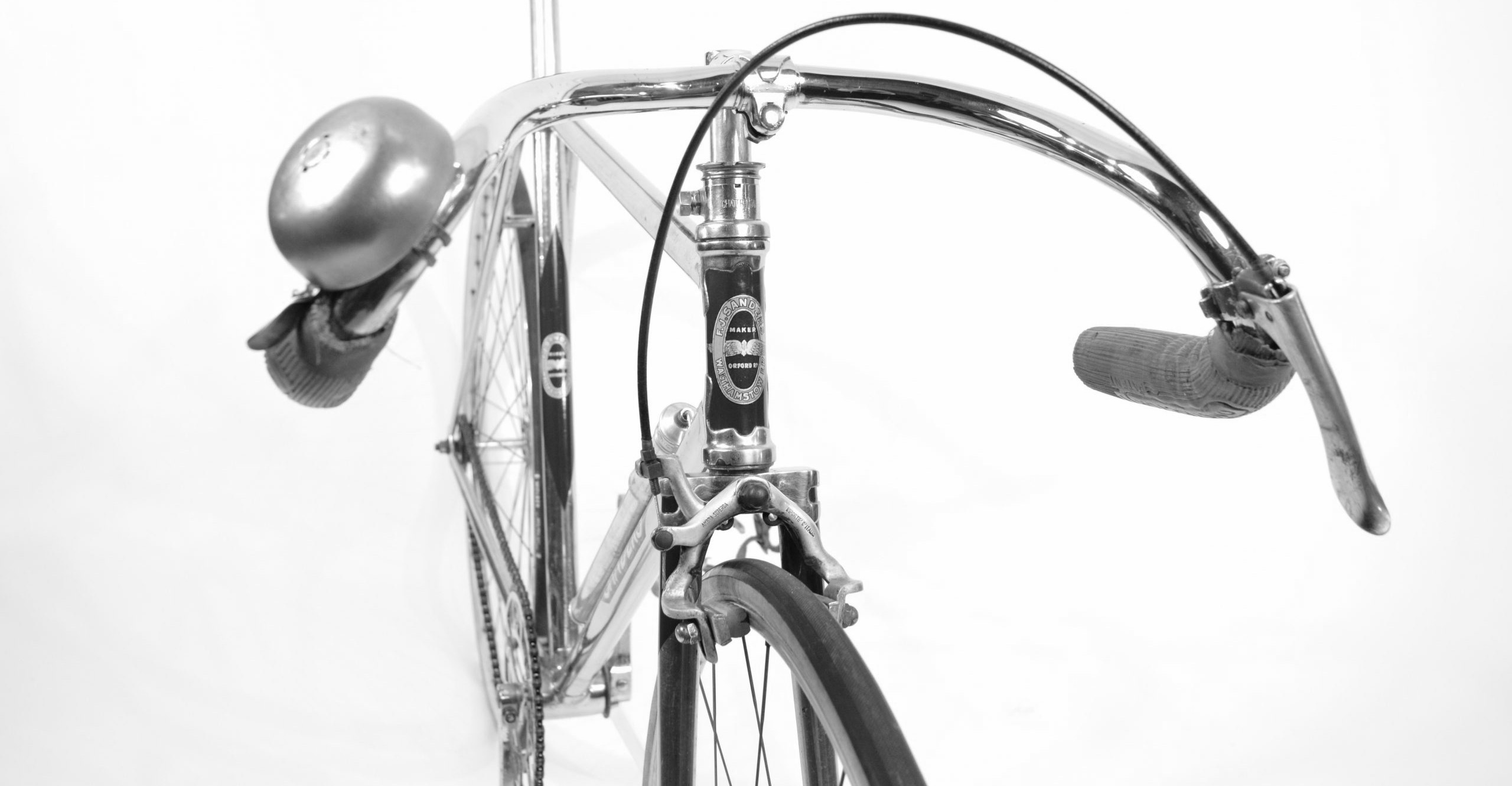Racing under the radar: South Africa’s apartheid era ‘ghost riders’ in the pelotons of European road cycling
Posted: Tuesday 18th August 2020
Since 1970 South Africa has been a cycling excommunicate because ‘not only the African countries, but also those of East Europe, are absolutely solid for this position.’ Those words within inverted commas are the words of Adriano Rodoni, president of the Union Cycliste Internationale (UCI) and of the Federation Internationale Amateur de Cyclisme (FIAC). This definitive declaration was made in March this year (1976). The accuracy of its quotation is incontrovertible. John Burns, ‘Personally Speaking’. South Africa Where Now? 1976.
You don’t need me to tell you that South Africa is still persona non grata in world cycling. But that doesn’t mean you can’t include a few races in a trip to Europe. Let me tell you how … As Alan van Heerden discovered, it’s not so hard to get a foreign license in Europe although you have to pick your country carefully it can be done in Belgium and is pretty easy in France and Britain … And once you’ve got it, you can race almost wherever you choose. Les Woodland, ‘Viewpoint’. South African Cyclist. October 1978, Vol.3, No.12, p.1.
It is common knowledge in modern cycling circles that numerous foreign cyclists defied the international boycott and competed in road races in apartheid South Africa during the 1970s and 1980s. Less well known is the fact that, at the same time, a number of white South African cyclists participated in road races in Europe despite the international ban on them from doing so. Both their presence in Europe and how they circumvented this ban were cloaked in secrecy at the time. Their exploits were poorly documented back then and have since been largely forgotten, leaving a significant gap in the historical record of the sport and of South African cycling in particular.
This is the untold story of these South African ‘ghost riders’ in Europe: who they were, where they raced, who they raced against, what they achieved, and why they ultimately disappeared. First, an outline of the cycling scene which existed at that time is presented to highlight the circumstances which led to their emergence.
Origins: How the ‘ghost riders’ emerged
The South African Rapport Toer multistage amateur road race was the major stimulus for the emergence of South African ‘ghost riders’ in Europe. Held annually every October from 1973 onwards between the cities of Cape Town and Johannesburg over two weeks and some 2,000km, the race included both foreign riders and South Africans. The riders were grouped into small shadow ‘national’ teams. However, each team rode in the colours of a commercial sponsor. The foreign riders involved in various editions of the event included American, Belgian, British, Canadian, French, German, Irish, Italian, Portuguese, Rhodesian and Swiss nationals, all of whom had accepted invitations from the race organisers. (2)
From its inception, the Rapport Toer was a ‘rebel race’. It was staged in defiance of both the UCI (Union Cycliste Internationale) and the IOC (International Olympic Committee) which had banned South African cycling from international competition in the 1960s for practicing racial discrimination in the sport. Foreign riders who participated in the Rapport Toer thus risked being sanctioned both by their own national associations and by these international sporting bodies. Many were subsequently duly penalised, although the severity of their punishments – usually in the form of periods of suspension from competition – varied considerably.
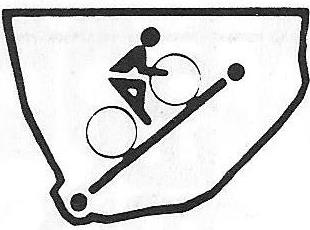
The majority of South Africans who participated in the Rapport Toer were white riders affiliated to the SACF (South African Cycling Federation) which administered segregated white competitive cycling in the country at the time. In addition, a separate team of black African riders belonging to the SAAA&CA (South African Amateur Athletic and Cycling Association) featured annually in the event from the outset. Segregated black African cycle sport was concentrated on South Africa’s gold and platinum mines, many of which had on-site recreational facilities which included purpose-built cycle tracks for the use of their black migrant workers who were housed in mine hostels.
Notably absent from the Rapport Toer in the 1970s were South African Coloured cyclists who were affiliated to SACA (South African Cycling Association). This body disassociated itself from the SACF on the grounds that, apart from in the Rapport Toer, the SACF continued to practice apartheid in the sport.
The Rapport Toers of the 1970s
Having the financial backing of the Afrikaans-language Sunday national newspaper, Rapport, ensured that from the outset the eponymous race received widespread publicity in the media. However, it came as a shock to the local cycling community when, from the first event in 1973 onwards, foreign riders continued to dominate the race. They demonstrated superior abilities, tactics and teamwork to outmanoeuvre the South Africans. Foreign riders won the event in the first four years of its existence from 1973 to 1976 (3). The only local rider to seriously challenge the foreigners was Alan van Heerden, who won numerous individual stages of the race in successive years to take the sprint points title every year from 1973 to 1978.
After winning the 1974 Rapport Toer at the age of 36, the veteran British ex-Tour de France rider, Arthur Metcalfe, commented:
“It was a very good race, comparatively flat overall but hard fought with a high standard of competition. I had written off my chances, but with three days to go with two stage wins I took over the yellow jersey. Of the South Africans I was particularly impressed with van Heerden, who finished fifth overall but was particularly strong on the individual stages.” (4)
Metcalfe was subsequently suspended by the British cycling authorities for participating in the race.
Faced with the repeated failure of South African riders to win the race outright, the view formed that local riders would continue to be overshadowed by foreigners in the Rapport Toer until such time as they were able to gain experience by racing in premier road events in Europe. The problem was that the international ban prevented this from occurring. Was there any solution?
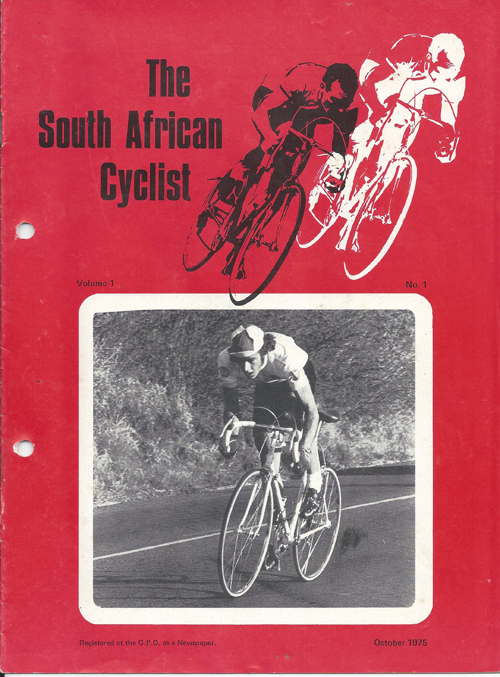
The ‘French Connection’
In July 1975, the Tour de France was won by the Peugeot Cycles-sponsored French rider, Bernard Thévenet. In winning the Tour, Thévenet had defeated the reigning world professional champion and Belgian superstar, Eddy Merckx.
In October 1975, Thévenet arrived in South Africa and followed that year’s Rapport Toer as an honoured guest of the race organisers, appearing at the daily stage prize presentations. His presence at the race was hardly fortuitous. At the time Thévenet’s French sponsor, Peugeot Cycles, was linked to the manufacture of Peugeot bicycles locally. These were being produced under licence to the parent company and Peugeot South Africa was involved in regularly sponsoring SACF cycling, including local teams in the Rapport Toer. (5)
Also at this time, the cycling division of the Parisian sports club, the ‘Athletic Club de Boulogne-Billancourt’, generally abbreviated to ‘ACBB’, was sponsored by Peugeot Cycles France. Historically, this club had nurtured many top cyclists in their amateur days including André Darrigade, Jean Stablinski, Shay Elliott (Ireland) (6) and later Bernard Thévenet himself. The club’s new policy, adopted in the 1970s, of accepting promising foreign amateur riders as members led to an influx of English-speaking riders into the club from Australia, Britain and Ireland. This ACBB ‘foreign legion’, resplendent in the iconic white and black checkerboard strip of the Peugeot <i>marque</i>, was soon dominating amateur road racing in Europe. Their ranks included many who went on to become leading professional roadmen: Stephen Roche (Ireland), Phil Anderson (Australia) and, from the UK, Robert Millar, Graham Jones and Paul Sherwen.
Then, at the beginning of 1978, the ACBB club acquired a new foreign member. This was none other than the leading white South African cyclist of the decade, Alan van Heerden. Quite how this was achieved despite the international ban on South African cyclists remains a mystery to this day. However, the evidence of the close ties forged between the SACF’s Rapport Toer, Peugeot Cycles in both France and South Africa, Bernard Thévenet and the ACBB suggests that it was the direct result of an arrangement to which they were all privy.
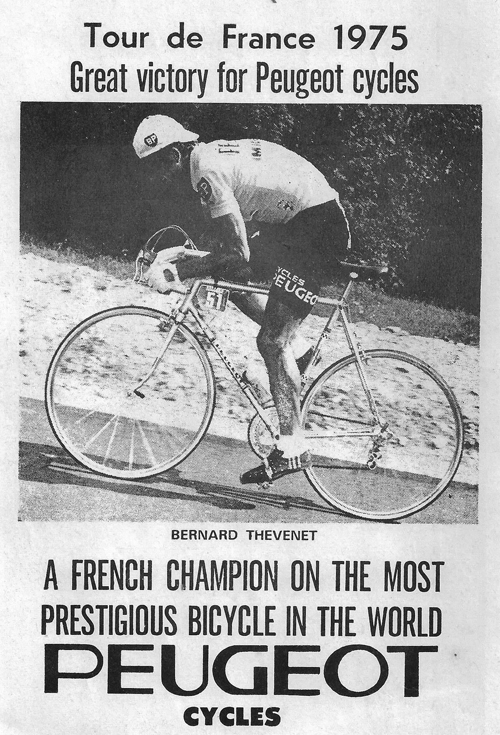
Van Heerden’s big Continental breakthrough and its aftermath
Initially, after having joined up with the ACBB in Paris in early 1978, van Heerden kept a low profile. If questions were asked, it was suggested that he was either an American or from Britain. Then he enjoyed successes in several French amateur semi-classic road races. He won a stage of the Tour d’Ille-de-France and triumphed in both the Paris-Varennes and the Paris-Orléans one day races.
Van Heerden finally hit the headlines in the French cycling press in June 1978 when he finished third in the prestigious amateur version of the Paris-Roubaix classic race riding in ACBB colours. He was a member of a four-man breakaway in the final stages of the 200km race over the infamous cobbled roads of the ‘Hell of the North’. His other breakaway companions were all Belgians. Fearful of van Heerden’s by now well-known strong finishing sprint, the three Belgians engineered the late escape of their top rider, Fons de Wolf (7), who went on to win in 4 hours 38 minutes, 1:34 ahead of Ronny Claes with van Heerden third. This result attracted widespread attention in European cycling circles and prompted serious questions about van Heerden’s national identity.
The July 1978 edition of the South African Cyclist carried the following report under the headline. ‘French Federation bans South Africans’: “Three South African amateurs have been banned from racing in France. The French Federation announced its decision following Alan van Heerden’s third place in the Paris-Roubaix classic four days earlier. The other two concerned are Johnny Warne and Alan Dipple, who rode but did not finish.” (8)
Despite this ban, van Heerden continued to race in France for a while, finishing ninth in the Paris-Montargis race in late June, 1978. However, faced with total exclusion from European amateur races, Van Heerden returned to South Africa and in August 1978 he won the national road championship held in Pretoria over 177km in a time of 4:45.4. He was clearly preparing to challenge for final victory in the Rapport Toer in October 1978. However, the overall winner of the event proved to be the Portuguese rider, Marco Chagas, with van Heerden taking the points title for the sixth time.
Nevertheless, van Heerden’s European amateur successes had attracted the attention of professional cycling teams and he signed a two year contract with the French professional Peugeot team whose members included Bernard Thévenet. (9) It was reported that the Peugeot pro squad would pay van Heerden the equivalent of ZAR600 per month and ZAR80 for every event he completed. (10)
The scene was thus set for van Heerden to embark on a career as a professional road cyclist in Europe during the 1979 season.
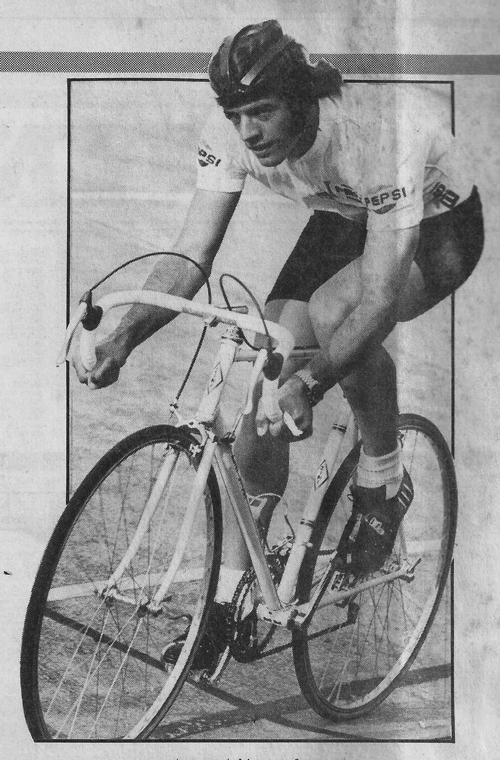
Alan van Heerden’s years as a Peugeot professional in France
The Belgian superstar, Eddy Merckx had dominated world professional cycling from the mid-1960s through to the mid-1970s. On the cusp of 1980, a new generation of pro cyclists appeared on the European scene. Thévenet had won his second Tour de France in 1977 but was rapidly succeeded by the new French star, Bernard Hinault, who claimed the overall race yellow jersey in 1978 and 1979 and then again in 1981,1982 and 1985. In the one day classics, the Dutch riders of the TI Raleigh squad were dominant, challenged by the Belgian Freddy Maertens and the Italian Francesco Moser.
Alan van Heerden (11) joined the Peugeot professional team at the start of the 1979 European road season. As an ACBB amateur in 1978, he had impressed as a rider with a ‘big engine’ and a good finishing sprint. The Peugeot pro team’s plan for 1979 was to use van Heerden as a domestique, serving as both a squad workhorse and a lead-out man for their top sprinter, Michel Laurent. Van Heerden achieved several good placings in the early season events in the South of France. Riding as a member of the Peugeot team in the Giro d’Italia in May 1979, van Heerden escaped with a small group of riders on the Giro’s seventh stage – at 252km the longest in the race – and won the stage in the final sprint. Finally he had achieved a victory in a premier European pro event. (12) Little was reported back in South Africa of van Heerden’s European racing during the remainder of the year but for the first time in its history he did not compete in the Rapport Toer.
Returning to Europe for the 1980 racing season, van Heerden began to contribute a regular column to the South African Cyclist on his European racing experiences. He reported that the Peugeot pro squad for 1980 had nineteen riders. Fourteen were French while there were three other English-speakers: Phil Anderson (Australian) and the Britons Graeham Jones and Robert Millar. The team leaders were the Dutchman, Hennie Kuiper (1975 world pro road champion) and the French roadman-sprinter, Michel Laurent. In recent years, the Peugeot squad had been overshadowed by Hinault’s Renault team and planned to make amends in 1980.
The Peugeot team riders were active in the 1980 early season races in the South of France. Van Heerden finished eleventh in the 120km Grand Prix St Raphaël contested by 140 riders and he had stage placings in the Tour of the Mediterranean. This race was won overall by the Dutch TI Raleigh rider and 1978 world road champion, Gerrie Knetemann. In the first major stage race of the year, Paris-Nice, the Peugeot team triumphed, with team leader Gilbert Duclos-Lassalle winning the event. However, in his May 1980 column in the South African Cyclist van Heerden reported that because he was a South African national he was continuing to experience problems in obtaining a UCI professional racing licence. Only intervention by the Peugeot management served to resolve the problem for the remainder of 1980.
Van Heerden competed in the early season classics with mixed results. In the Het Volk he finished 28th and, together with Robbie McIntosh, he started in the 265km Ghent-Wevelgem classic but fell badly and was taken to hospital. He started in the Paris-Roubaix but retired after 168km. Francesco Moser of Italy won the race while Peugeot’s Duclos-Lassalle finished second. The 1980 Liege-Bastogne-Liege was held in a snow storm and van Heerden retired along with 120 of the 192 starters. Bernard Hinault won the event from van Heerden’s team mate, Hennie Kuiper.
In his June, 1980, column in the South African Cyclist, (13) van Heerden wrote:
“First of all I would like to explain why I don’t finish some of these races, as I think a lot of the readers do not understand what my job is once the race starts. I have to follow all breaks and if I get away, ride as hard as possible with the bunch that breaks, this makes the big ‘boys’ in the Peleton also ride hard to bring us back, tires them and so that at the end it’s much easier for riders like Kuiper, Laurent of Peugeot to attack. I also do a lot of pushing up the hills and pass wheels if a top rider in our team punctures and our team car is not near. Of course, I get my chance in smaller races – the classics are hell – 250-270kms long at average speeds of 40/45kph. Lots of wind – small road falls – bad weather – punctures – so I can assure you all that after a race one feels completely drained.
The Het Volk was 265km and 6 cobble climbs, most of these on foot, as it is impossible to ride up unless you hit the hill in the first five, because there is nearly always a fall at the bottom of the hills and what a sight it is to see 30 or so riders on top of one another. This event was won by Michael Pollentier followed by Moser and Jan Raas. I was placed 28th out of a field of 230 starters, which I think is a reasonable performance.”
Van Heerden obviously found the European professional road racing scene to be entirely different to anything he had experienced in amateur road racing as it then existed in South Africa. In one of his columns he wrote: I am still trying to get used to the sprint finishes, pushing, pulling and switching all the time, and coming off at 65kph is no joke!! (14). Moreover, it is clear that he remained a domestique in the 1980 Peugeot squad despite his achievements in 1979. Realistically, there was little value to the Peugeot brand in Europe at that time in having a South African as a team leader of their squad. Nevertheless, back in 1979 when he first signed for Peugeot van Heerden had been promised that he would succeed the aging Michel Laurent as the team’s leading sprinter.
In 1980 van Heerden also raced in Britain for, as he wrote in his regular monthly column in the South African Cyclist: We went to England to ride the longest single day race in Europe – the London to Bradford 408km [250 miles]. Fifty-two riders started at 5:30am and included in the field were teams from La Redoute, Peugeot, Fangio, Daf Trucks and all the top British pros, including Barry Hoban, Sid Barras and Keith Lambert. The race started at an easy tempo until the 150km mark and from then we raced hard as there were 12 Primes every 20 to 40km. The Peugeot and La Redoute riders joined forces and between them won R8,000 of the R12,000 prize list. Jean Michael of La Redoute won from Graham Jones Peugeot and Dick Heirweg Daf Trucks. I finished ninth and was very pleased with my performance. The race took 11 hours and the weather was ideal.
Van Heerden’s two-year professional contract with the Peugeot Europe team extended until the end of 1980 but was not renewed, apparently by mutual agreement. He received several European pro contract offers for 1981, including one from Herman van Springel’s Safir squad, but he decided to return permanently to South Africa.
By the time van Heerden arrived back in his homeland towards the end of 1980, he was a widely travelled 27 year-old who had become an established European pro roadman with impressive palmarès. But he was not the only South African cyclist to ride in the European pelotons at this time.
Robbie McIntosh’s time as both an amateur and professional cyclist in Belgium
In 1977, the Rapport Toer produced its first home-grown winner in the form of Robbie McIntosh. He was a white English-speaking cyclist from the predominantly English-speaking province of Natal. Without roots in the white Afrikaner community which strongly identified with the event, from the Rapport Toer sponsors’ point of view McIntosh may not have been the ideal first local winner, but at least they had the consolation that he was a South African cyclist.(16)
McIntosh subsequently competed in Europe as both an amateur and a professional although the route he took is far from clear. During 1978, McIntosh’s name disappeared for a period from the results of races in South Africa. He was apparently racing as an amateur in Belgium, participating in events staged by the Belgian WAOD (Wielerbond Aangesloten Openbare Diensten), which was a cycling organisation not affiliated to the UCI but rather to the ICF (International Cycling Federation). WAOD and the ICF confined their activities to organising races for amateurs and veterans, with both organisations having strong connections to the Flemish-speaking part of Belgium. McIntosh returned to South Africa for the 1978 Rapport Tour but was forced to retire during the race due to injury. In mid-1979 he once again enjoyed amateur racing in Belgium. Finally, in 1980 McIntosh signed a two-year contract with the Belgian Fangio professional team, thus joining van Heerden on the European professional circuit.
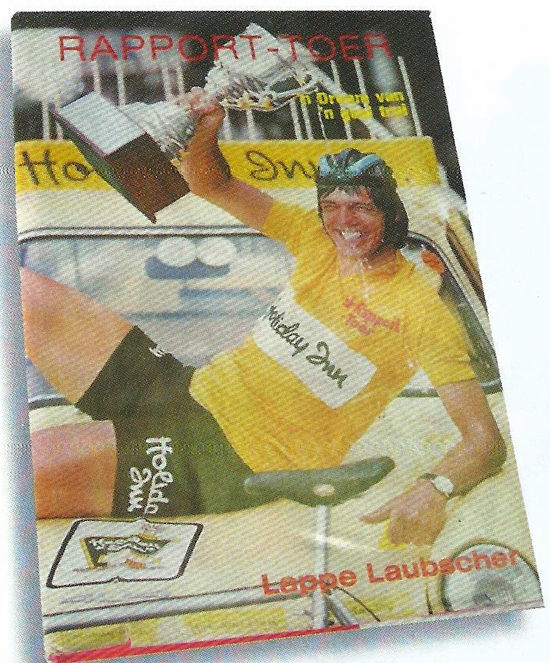
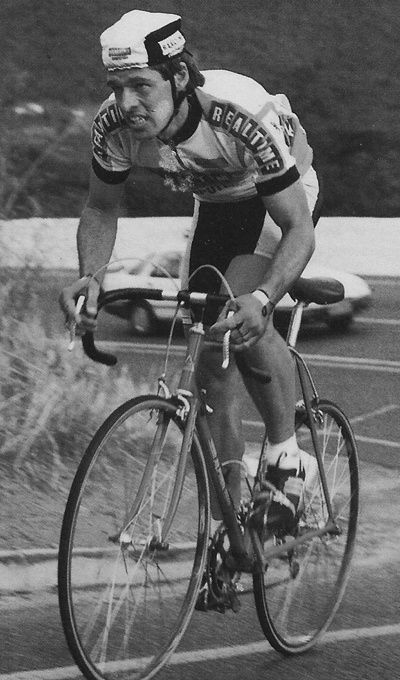
The Fangio team concentrated on contesting the busy summer-long programme of events on the Belgian kermesse circuit as well as the early season northern one-day classics: Ghent-Wevelgem, Het Volk, Fleche Wallone, Liege-Bastogne-Liege, Tour of Flanders and Amstel Gold. It was mainly in these classics that McIntosh and his Fangio team mates (who for a time included both the black British cyclist, Maurice Burton, and the New Zealander, Wayne Hildred) encountered the leading Continental pro teams and riders of the day consisting of Renault (Hinault), Peugeot (Kuiper), GIS (Moser), Flandria (Maertens) and TI Raleigh ( Zoetemelk, Raas and Knetemann). Writing of the 1981 Amstel Gold event, McIntosh observed:
I raced against Hinault in the Holland Amstel Gold race over 244kms and I could not believe how fast he climbs hills. Two or three kicks and he’s away off the front. (17)
Traditionally, the local Belgian pro teams which contest the Flemish kermesses are small. Team members tend to race as individuals and to form alliances and ‘combines’ – some cutting across team loyalties – which are fluid, often changing from race to race. As McIntosh notes about one such 1981 event:
On 7 June in the 199km race at Ganshoren Etienne de Wilde (Splendor) won a sprint finish from Planckaert (Splendor) and Freddy Maertens (Boule d’Or). I was in the finishing sprint and was placed 8th. Van der Perre who won the previous event was 24th. There were 101 starters. Although I felt very good in this event, I was told ‘not to win’, so was quite content to sprint with the others. A lot of this kind of ‘fixing’ takes place in Pro races over here. (18) In similar vein later in the year he wrote: My performances over the last few weeks have been good, but I have had to drop a race or two after ‘pay offs’ by the top riders. A ‘pay off’ of 48,000 Belgium Francs is worthwhile! (19)
While not figuring in the Grand Tours, teams like Fangio often participated in smaller stage races both in Belgium and elsewhere. In 1981 the Fangio team raced in a small (unidentified) Spanish stage race. McIntosh, who finished fourth overall in the event, wrote of this: My ride in the Spanish tour pleased me and I believe I could have won it, when I was away with 8 others, including a team mate, and I only needed one minute. It seemed possible until my manager came up in his car and told me to slow down. I asked ‘Why’ but did not receive an answer. (20)
At the end of the 1981 European road season, McIntosh returned to South Africa to once again participate in the Rapport Toer. Apparently he had originally intended to head a Fangio team in the race but this did not materialise. Instead he participated as a member of the ‘Aticon Construction’ team which included Alan van Heerden who had as yet never won the Rapport Toer. As matters turned out, McIntosh won the event overall for the second time, with van Heerden finishing second. He triumphed amidst rumours of rivalry and dissention within the Aticon team between McIntosh and van Heerden.
McIntosh returned to Belgium and the Fangio team in 1982 but at some point during the year he decided to return permanently to South Africa. The period during which van Heerden and McIntosh raced as members of professional teams in Europe was over. However, there were other South African cyclists who were either already seeking to emulate them or planning to do so shortly.
Alternative routes into European cycling in the 1970s
Ernst ‘Ertjies’ Bezuidenhout was a promising young South African roadman of the 1970s who first sprang to prominence by winning the King of the Mountains title in the 1978 Rapport Toer. In 1979 he succeeded in racing in France as an amateur but his route to getting there was very different to that taken previously by Alan van Heerden. After the ‘van Heerden affair’ of 1978, the French cycling authorities were on the alert for South African cyclists attempting to circumvent the international ban.
Aided by contacts he had established with British cyclists during the 1978 Rapport Toer, Bezuidenhout first joined a London club under the assumed name of ‘Ernest Bessenden’ and obtained an international racing license from the BCF (British Cycling Federation). He then joined a cycling club in a French provincial town and began competing in French amateur road races.
While enjoying the intense competition of the French amateur races, Bezuidenhout ultimately found the combination of living alone in a foreign country, competing under an assumed name, bouts of illness and not being fluent in French all too much to bear. He returned to South Africa after five months in France. Nevertheless, the experience obviously bore fruit in that he again won the Rapport Toer King of the Mountains title later in the year. (21)
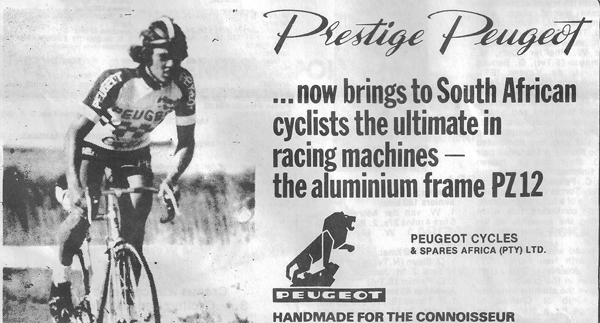
At the time, other leading South African cyclists were equally keen to follow in the wake of van Heerden, McIntosh and Bezuidenhout and try their luck in the European pelotons.
Two other South African cyclists who settled in Europe as amateurs were Robbie de Villiers who went to Portugal and Mark Beneke who travelled to Italy.
De Villiers was a teenage fan befriended by the Portuguese team at the 1978 Rapport Toer. In January 1979 he moved to Portugal where he joined a junior club and subsequently raced in amateur junior and senior races in both Portugal and Spain with considerable success. He adopted the name ‘Robbie Danielle’ and rode in the Springbok amateur team under this name in the 1982 Rapport Toer, finishing in the top ten overall. ‘Cycling SA’ lists Robbie de Villiers as having been awarded national Springbok colours for participating in the Rapport Toer in 1982, 1983 and 1984.
In March 1980, the South African Cyclist carried an article entitled ‘Mark Beneke to join growing band of South Africans in Europe’, stating that: He will try and make a name for himself with a view to obtaining a pro contract. He speaks Italian well and has many friends among the Italian cyclists. (22) In 1979, Beneke had unsuccessfully challenged Alan Dipple for victory in the Rapport Toer, ending second overall. In 1980 he rode the event as a member of the Italian ‘Mum for Men’ sponsored team and was accused by locals of being unpatriotic. Beneke was to remain in Italy for three years before returning to South Africa and winning the Rapport Toer in both 1985 and 1991.
Flying racing visits of South African cyclists to Europe
In addition to these, there were those South African cyclists who went on brief racing trips to Europe. They were of several different types:
- Selected SACF amateur teams that travelled to Belgium and invariably raced in WAOD events which were independent of the FIAC/UCI.
- Individuals with ancestral claims to citizenship in a European country who raced there while holidaying with relatives.
- Members of the South African Veteran Cycling Association who regularly participated in the annual Veterans’ World Championships held annually in St. Johann, Austria.
All three of these kept an extremely low profile during their racing trips and little was reported on them in the cycling media back home. These variations of little-known and rarely reported on brief racing visits to Europe continued on into the 1990s.
In some further instances, riders emigrated permanently and assumed other nationalities. After doing so, several achieved high international honours in the sport, having first developed their cycling talents in South Africa. They literally quietly disappeared from the South African cycling scene.
South African-based professional competitive cycling in the 1980s. When Alan van Heerden returned permanently to South Africa at the end of 1980 he found the sport there to be still strictly amateur. He immediately applied to be reinstated as an amateur by the SACF. However, his request was refused. At best he was offered an arrangement whereby he would be debarred from the sport for a full year and only thereafter be eligible to apply for reinstatement as an SACF amateur.
At the time, the international boycott of South African cycling remained firmly in place. As a result, South African amateur cyclists were excluded from competing in both the UCI world championships and the Olympic Games as well as from events sanctioned by these international sporting bodies. But the SACF had a plan in mind. With the UCI administratively divided into the amateur FIAC and the professional FICP, it was noted that FICP rules permitted nations with six or more professional cyclists to affiliate to this international body. Once affiliated, a nation’s professional cyclists were eligible to participate in the annual UCI/FICP world championships and other professional events sanctioned by the FICP. In the light of this, the SACF sanctioned ‘pro-am’ racing in South Africa from the beginning of 1981. In so doing, it actively encouraged its cyclists to take out professional licences with the SACF. Alan van Heerden did so immediately and was soon followed by others. This marked a new chapter in the attempt by South African cycling authorities to circumvent the international boycott which had been in existence for more than a decade.
Initially in 1981, van Heerden rode in South African pro-am events in Peugeot colours. He soon changed to Deale & Huth colours, a leading local lightweight dealer, and was joined there by another pro, Tony Impey (father of Darryl Impey, who in 2013 became the first South African to wear the Tour de France yellow jersey, riding for the Orica Greenedge squad). By the time of the 1981 Rapport Toer van Heerden headed a small contingent of professionals in the Aticon Construction team. In the 1981 Rapport Toer, Ertjies Bezuidenhout was leader of the rival Peugeot team of local professionals. South Africa now had the six professional cyclists required to register with the FICP.
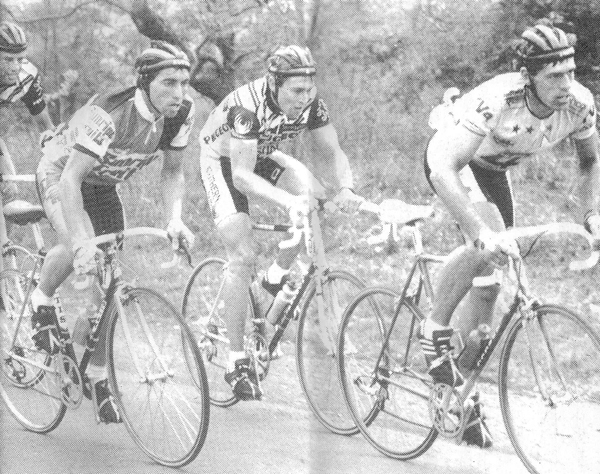
The acid test of this new initiative came in 1982. The SACF obtained an invitation to send a team of its home-based professionals to race in several European events. Headlines in the July 1982 issue of the South African Cyclist read: ‘South African Professional Team to Compete in Europe’. According to the report, a five man team of South African-based professionals would participate in several European one-day events and then in a stage race in West Germany. However, the October 1982 issue of the South African Cyclist recounted a very different tale. The team had arrived in Europe but had been refused racing licences by the UCI/FICP, whose officials declined to discuss the matter further: South African cycling chief, Mr. Raoul de Villiers, has stated that legal action will be taken against the International authorities, who prevent South African cyclists from competing abroad. Mr. de Villiers who is president of the S.A. Cycling Federation which governs professional and amateur cycling, said that it has become more difficult over the past three years. It is obvious that the Union Cycliste International have gone out of their way to block our every move. This had all come to a head by the recent refusal by Mr. Jekiel (UCI General Secretary) to issue licences to a group of South African professionals who were invited to compete in the Tour of Germany. The five professional riders were considerably out of pocket and are threatening to sue the SACF for their expenses. (23)
The SACF’s attempt to circumvent the international boycott by introducing a class of professional cyclists in South Africa had thus ultimately ended in failure. South Africa now had a small group of local professional cyclists eligible to ride only in local pro-am races. This was the situation that prevailed in the sport until the ending of apartheid in the early 1990s. Shortly thereafter both the UCI and the IOC abandoned the amateur/professional distinction. In the post-apartheid era, with racial discrimination in sport officially scrapped, South African cycling was readmitted to international competition. This finally brought to an end a deeply troubled era spanning more than twenty years in the history of South African cycle sport.
Today, the South African ‘ghost riders’ in the European pelotons of the 1970s and 1980s are but distant memories. Both Alan van Heerden and Ertjies Bezuidenhout subsequently died in tragic circumstances – Alan in a 2009 motor accident; Ertjies in 2012 after competing in a cycle race for the first time in 20 years. Others from that era are now in their ‘fifties and ‘sixties. Together they constitute South African cycling’s ‘lost generation’.
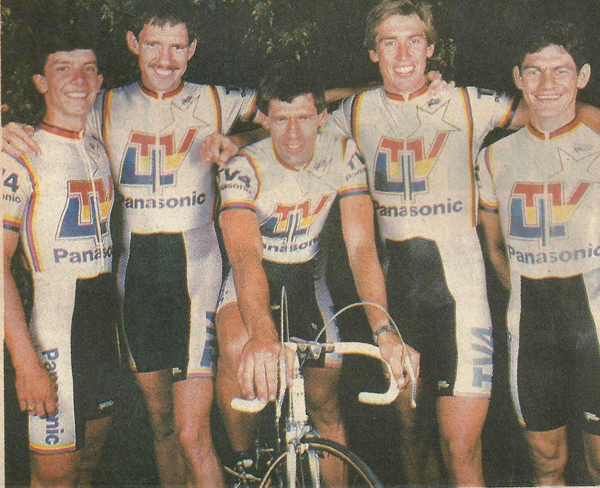
ENDNOTES
(1) The sponsors varied down the years but included amongst others: Aticon, Bank of Lisbon, Datsun, Highway Electrical, Holiday Inn, King Rat, Milo, Mum for Men, Nyala, OK Bazaars, Pep Stores, Peugeot, Raleigh, Redex, Sustagen, TAP, Trek.
(2) Appendix A contains details of the results of the Rapport Toer.
(3) The winners were: 1973 J-P. L. Tagliavini (Italy); 1974 A. Metcalfe (UK); 1975 F. Mendes (Portugal); 1976 V. Fernandes (Portugal).
(4) Cycling, 26 October 1974.
(5) The Peugeot South Africa industrial plant was located in Babelegi, an apartheid era industrial area located in a ‘Bantu homeland’ outside Pretoria. To attract investment, these ‘border industry’ zones offered industrialists major tax concessions along with a source of cheap labour. In contrast, the Raleigh South Africa plant by virtue of being located in the Johannesburg conurbation enjoyed neither of these advantages. Peugeot SA was presided over by a former cyclist and leading SACF official. Both the Raleigh and Peugeot cycle-manufacturing plants no longer exist in South Africa.
(6) Darrigade and Stablinski became top French professionals in the 1950s and both won the UCI pro world road championship. Shay Elliott was a contemporary who held the Tour de France yellow jersey for three days in 1963.
(7)After turning professional, de Wolf won the Tour of Lombardy in 1980 and the Milan-San Remo in 1981.
(8)Report by Les Woodland. South African Cyclist. July 1978. Vol.3, No.9, p.1. Both Warne and Dipple were top South African roadmen of the time. How they came to be in the race is unknown. Dipple was to win the Rapport Toer in 1979. He later emigrated to Australia and successfully raced there.
(9)At that time the world cycling governing body, the UCI, was divided into the FIAC which dealt with amateur cycling and the FICP which was concerned only with professional cycling. The two were de facto largely independent of one another. Thus hypothetically a rider rejected by the FIAC could be accepted by the FICP. The UCI absorbed both the FIAC and the FICP in the 1990s.
(10) South African Cyclist. October 1978.Vol.3, No.12, p.3.
(11) Alan van Heerden (1953-2009) died in a motor accident in Johannesburg aged 56.
(12) The 1979 Giro d’Italia was won overall by Giuseppe Saronni of Italy.
(13) South African Cyclist. June 1980. Vol.5, No.7. p.3.(All quotes are verbatim).
(14)South African Cyclist. April 1980. Vol.5, No.5. p.2.
(15)South African Cyclist. July 1980. Vol.5, No.8. p.3.
(16) The August, 1978, edition of the South African Cyclist included an article by the Rapport sport journalist, Lappa Laubscher entitled ‘Robbie Suid-Africa se Eddy Merckx?’ In this article Laubscher claimed that unnamed local cycling pundits believed that McIntosh had only won the 1977 Rapport Toer because there were no Portuguese riders in the event.
(17) South African Cyclist. July 1981. Vol.6, No.8. p.4. Bernard Hinault won the 1981 Amstel Gold race in 5:57.49 with Roger de Vlaeminck second and Fons de Wolf third.
(18) South African Cyclist. July 1981. Vol.6, No.8. p.4.
(19) South African Cyclist. October, 1981. Vol.6, No.11. p. 3.
(20) South African Cyclist. July 1981. Vol.6, No.8. p.4.
(21) Source: ‘The Legend of Ertjies’ www.bicycling.co.za/news-people/…/ (Accessed 3 March 2014). Bezuidenhout finally won the Rapport Toer overall in 1984. He also won the Cape Argus Tour in 1984 and 1986. Bezuidenhout died suddenly in 2012, aged 56, following a racing comeback 20 years after retiring from the sport.
(22) South African Cyclist. March 1980 Vol.5, No.4, p.7.
(23) South African Cyclist. October 1982. p.1 (no Vol. or No. cited)
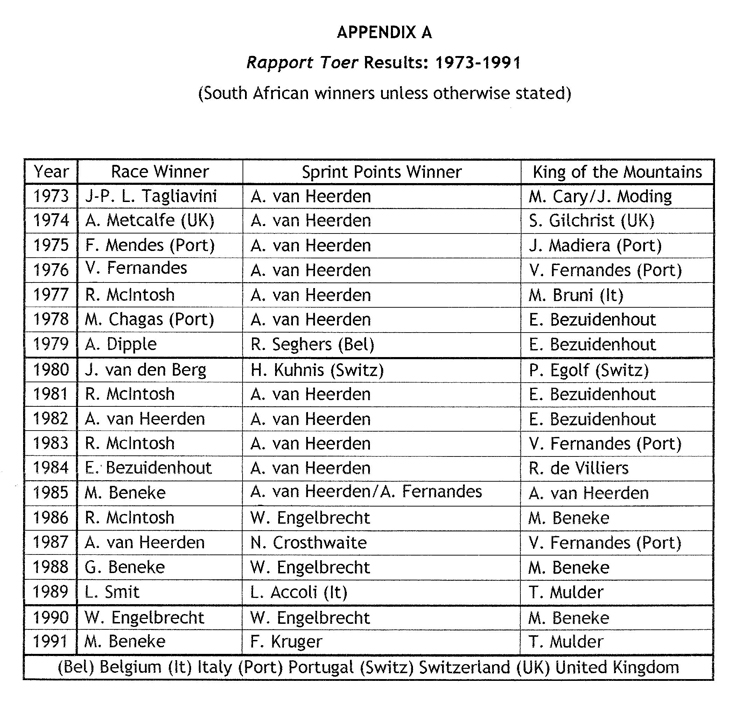
REFERENCES
Primary Source
The primary source used to compile this article is the South African Cyclist magazine. This was produced on a monthly basis and distributed to all SACF members. All monthly issues of the magazine from its first issue in October1975 up until April 1987 were examined for the article.
The founding editor of the South African Cyclist was Walter Jowett, who continued to edit it up until his death in 1983. He was a leading figure in the SACF for decades, serving on its executive for many years. Following Jowett’s death, the editorship was taken over by another leading SACF figure, Arthur Rice, assisted by his daughter, Lynn Rice. They continued to edit the magazine until 1987. It was discontinued thereafter.
Secondary Sources
Burns, John. South Africa Where Now? 1976.
Cycling. 26 October 1974.
Jowett, Walter. 1981. Centenary: 100 years of organised South African cycle racing. Pietermaritzburg: SACF.
Acknowledgement
I am indebted to Barbara Huckett, wife and lifelong tandem partner of the late Dave Huckett, for allowing me access to Dave’s complete set of the South African Cyclist magazine on which this article is based. Originally a member of the Lowestoft Wheelers in the UK, Dave was a leading member of Kings Park Cycling Club in Durban, South Africa for many years. He passed away in 2013.
Posted: Tuesday 18th August 2020
Contents
- Introduction
- Origins
- Rapport Toer
- The Rapport Toers
- The South African Cyclist
- French Connection
- Van Heerden
- Alan Van Heerden
- Peugeot Professional
- Paris-Roubaix
- The Het Volk
- Pelotons
- Robbie McIntosh
- The Fangio Team
- McIntosh
- Alternative Routes
- Ertjies Bezuidenhout
- De Villiers
- Flying Racing
- Competitive Cycling
- UCI
- Rapport Toer 1986
- The Acid Test
- TV4-Panasonic Pro Team
- Endnotes
- Appendix
- References
This article appears in the following categories.
Upcoming Events
Whether you are looking for a gentle social meet up, or a 100-mile ride browse the community’s upcoming events and plan your next weekend outing.
